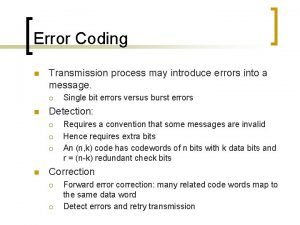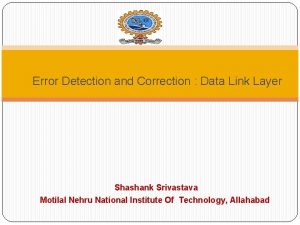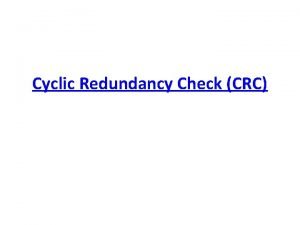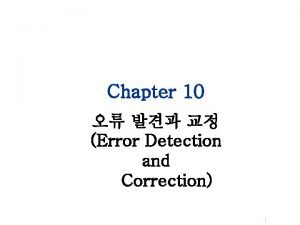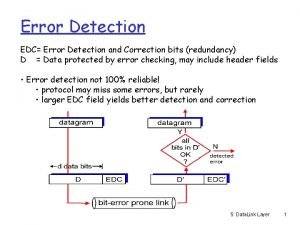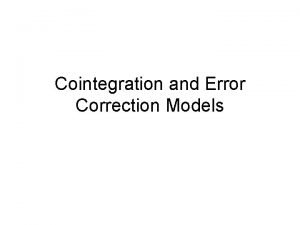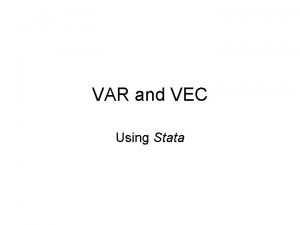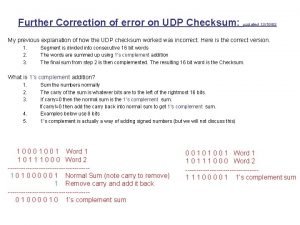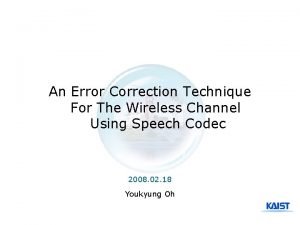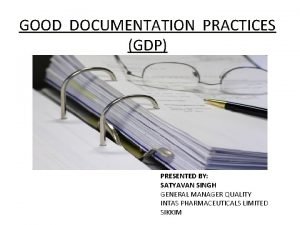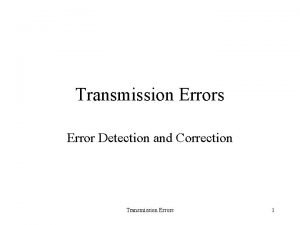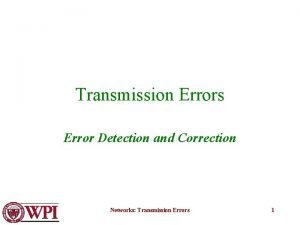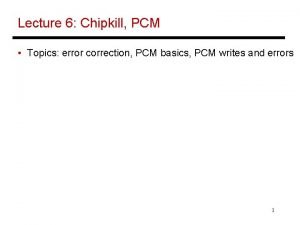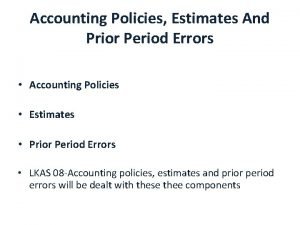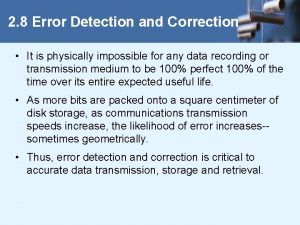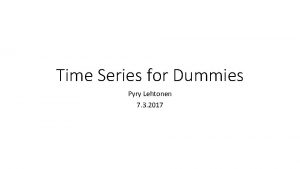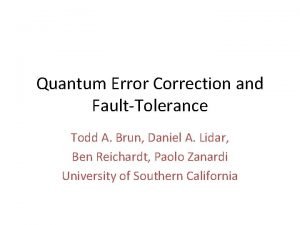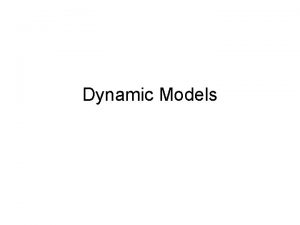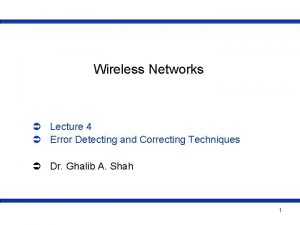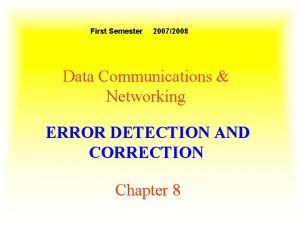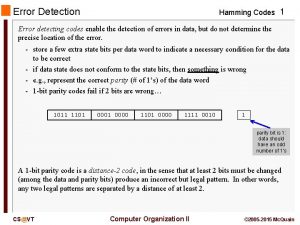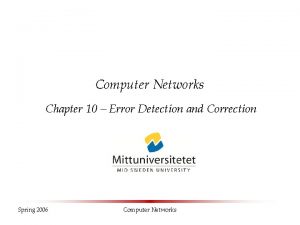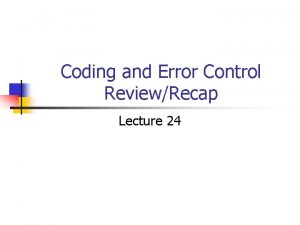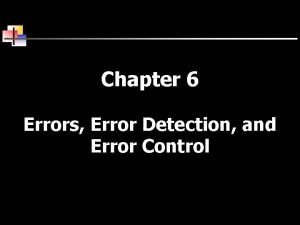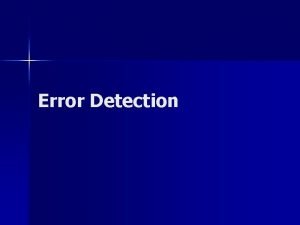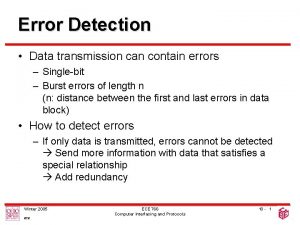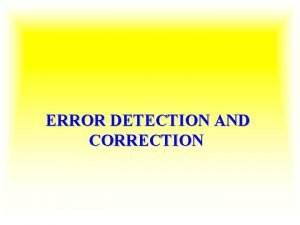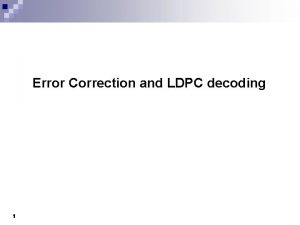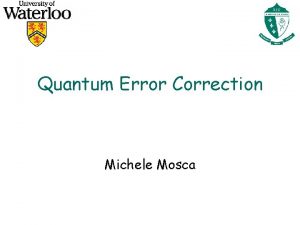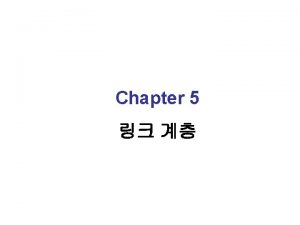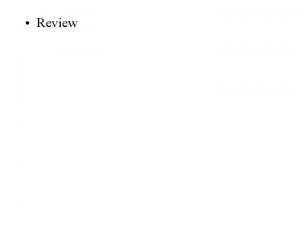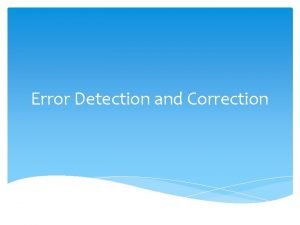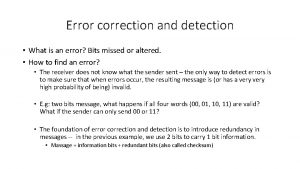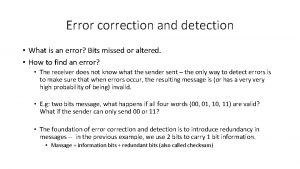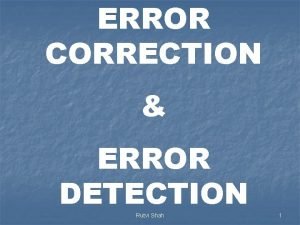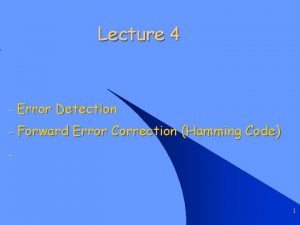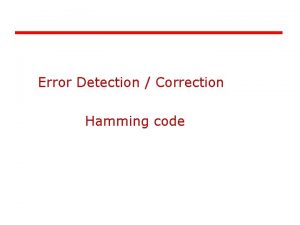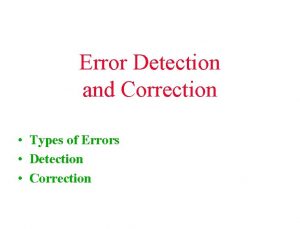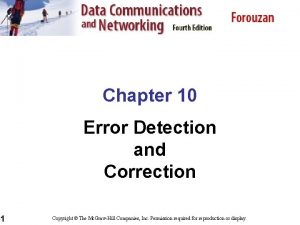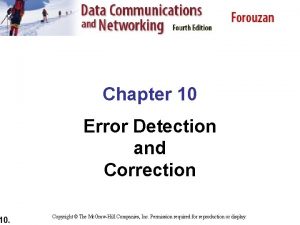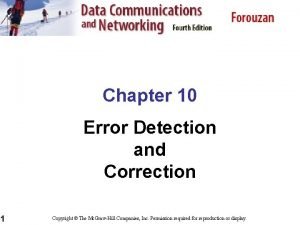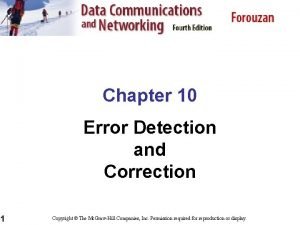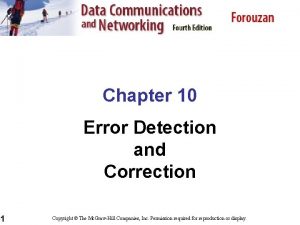Chapter 10 Error Detection And Correction Copyright The


































- Slides: 34

Chapter 10 Error Detection And Correction Copyright © The Mc. Graw-Hill Companies, Inc. Permission required for reproduction or display.

Note Data can be corrupted during transmission. Some applications require that errors be detected and corrected. 10. 2

10. 1 Introduction Let us first discuss some issues related, directly or indirectly, to error detection and correction. 10. 3

10. 1. 1 Types of Errors Whenever bits flow from one point to another, they are subject to unpredictable changes because of interference. This interference can change the shape of the signal. The term single-bit error means that only 1 bit of a given data unit (such as a byte, character, or packet) is changed from 1 to 0 or from 0 to 1. The term burst error means that 2 or more bits in the data unit have changed from 1 to 0 or from 0 to 1. Figure 10. 1 shows the effect of a single-bit and a burst error on a data unit. 10. 4

10. 1. 2 Redundancy The central concept in detecting or correcting errors is redundancy. To be able to detect or correct errors, we need to send some extra bits with our data. These redundant bits are added by the sender and removed by the receiver. Their presence allows the receiver to detect or correct corrupted bits. 10. 5

10. 1. 3 Detection versus Correction In error detection, we are only looking to see if any error has occurred. The answer is a simple yes or no. We are not even interested in the number of corrupted bits. In error correction, we need to know the exact number of bits that are corrupted and, more importantly, their location in the message. The number of errors and the size of the message are important factors. If we need to correct a single error in an 8 -bit data unit, we need to consider eight possible error locations; if we need to correct two errors in a data unit of the same size, we need to consider 28 (permutation of 8 by 2) possibilities. You can imagine the receiver’s difficulty in finding 10 errors in a data unit of 1000 bits. 10. 6

10. 1. 4 Coding Redundancy is achieved through various coding schemes. The sender adds redundant bits through a process that creates a relationship between the redundant bits and the actual data bits. The receiver checks the relationships between the two sets of bits to detect errors. The ratio of redundant bits to data bits and the robustness of the process are important factors in any coding scheme. We can divide coding schemes into two broad categories: block coding and convolution coding. In this book, we concentrate on block coding. 10. 7

10 -2 BLOCK CODING In block coding, we divide our message into blocks, each of k bits, called datawords. We add r redundant bits to each block to make the length n = k + r. The resulting n-bit blocks are called codewords. We have a set of datawords, each of size k, and a set of codewords, each of size of n. With k bits, we can create a combination of 2 k datawords; with n bits, we can create a combination of 2 n codewords. Since n > k, the number of possible codewords is larger than the number of possible datawords. The block coding process is one-to-one; the same dataword is always encoded as the same codeword. This means that we have 2 n - 2 k codewords that are not used. We call these codewords invalid or illegal. The trick in error detection is the existence of these invalid codes. If the receiver receives an invalid codeword, this indicates that the data was corrupted during transmission. 10. 8

10. 2. 1 Error Detection How can errors be detected by using block coding? If the following two conditions are met, the receiver can detect a change in the original codeword. 1. The receiver has (or can find) a list of valid codewords. 2. The original codeword has changed to an invalid one. 10. 9

10. 2. 1 Error Detection Figure 10. 2 shows the role of block coding in error detection. The sender creates codewords out of datawords by using a generator that applies the rules and procedures of encoding (discussed later). Each codeword sent to the receiver may change during transmission. If the received codeword is the same as one of the valid codewords, the word is accepted; the corresponding dataword is extracted for use. If the received codeword is not valid, it is discarded. However, if the codeword is corrupted during transmission but the received word still matches a valid codeword, the error remains undetected. 10. 10

Example 10. 1 Let us assume that k = 2 and n = 3. Table 10. 1 shows the list of datawords and codewords. Later, we will see how to derive a codeword from a dataword. Assume the sender encodes the dataword 01 as 011 and sends it to the receiver. Consider the following cases: 1. The receiver receives 011. It is a valid codeword. The receiver extracts the dataword 01 from it. 2. The codeword is corrupted during transmission, and 111 is received (the leftmost bit is corrupted). This is not a valid codeword and is discarded. 3. The codeword is corrupted during transmission, and 000 is received (the right two bits are corrupted). This is a valid codeword. The receiver incorrectly extracts the dataword 00. Two corrupted bits have made the error undetectable. 10. 11

Note An error-detecting code can detect only the types of errors for which it is designed; other types of errors may remain undetected. 10. 12

10. 2. 1 Error Detection Hamming distance One of the central concepts in coding for error control is the idea of the Hamming distance. The Hamming distance between two words (of the same size) is the number of differences between the corresponding bits. We show the Hamming distance between two words x and y as d(x, y). We may wonder why Hamming distance is important for error detection. The reason is that the Hamming distance between the received codeword and the sent codeword is the number of bits that are corrupted during transmission. For example, if the codeword 00000 is sent and 01101 is received, 3 bits are in error and the Hamming distance between the two is d(00000, 01101) = 3. In other words, if the Hamming distance between the sent and the received codeword is not zero, the codeword has been corrupted during transmission. The Hamming distance can easily be found if we apply the XOR operation (⊕) on the two words and count the number of 1 s in the result. Note that the Hamming distance is a value greater than or equal to zero. 10. 13

10. 2. 1 Error Detection Hamming distance Example 10. 2 Let us find the Hamming distance between two pairs of words. 1. The Hamming distance d(000, 011) is 2 because (000 ⊕ 011) is 011 (two 1 s). 2. The Hamming distance d(10101, 11110) is 3 because (10101 ⊕ 11110) is 01011 (three 1 s). 10. 14

10. 2. 1 Error Detection Minimum Hamming distance for error detection In a set of codewords, the minimum Hamming distance is the smallest Hamming distance between all possible pairs of codewords. If we want to be able to detect up to s errors, the minimum distance between the valid codes must be (s + 1), so that the received codeword does not match a valid codeword. (The reason is not focus) 10. 15

Example 10. 3 The minimum Hamming distance for our first code scheme (Table 10. 1) is 2. This code guarantees detection of only a single error. For example, if the third codeword (101) is sent and one error occurs, the received codeword does not match any valid codeword. If two errors occur, however, the received codeword may match a valid codeword and the errors are not detected. 10. 16

10. 2. 1 Error Detection Linear block codes Almost all block codes used today belong to a subset of block codes called linear block codes. The formal definition of linear block codes requires the knowledge of abstract algebra (particularly Galois fields), which is beyond the scope of this book. We therefore give an informal definition. For our purposes, a linear block code is a code in which the exclusive OR (addition modulo-2) of two valid codewords creates another valid codeword. 10. 17

10. 2. 1 Error Detection Minimum Distance for Linear Block Codes It is simple to find the minimum Hamming distance for a linear block code. The minimum Hamming distance is the number of 1 s in the nonzero valid codeword with the smallest number of 1 s. Example 10. 6 In our first code (Table 10. 1), the numbers of 1 s in the nonzero codewords are 2, 2, and 2. So the minimum Hamming distance is dmin = 2. 10. 18

10. 2. 1 Error Detection Parity-check code Perhaps the most familiar error-detecting code is the parity-check code. This code is a linear block code. In this code, a k-bit dataword is changed to an n-bit codeword where n = k + 1. The extra bit, called the parity bit, is selected to make the total number of 1 s in the codeword even. Although some implementations specify an odd number of 1 s, we discuss the even case. The minimum Hamming distance for this category is dmin = 2, which means that the code is a single-bit error-detecting code. Our first code (Table 10. 1) is a paritycheck code (k = 2 and n = 3). 10. 19

10. 2. 1 Error Detection Parity-check code The code in Table 10. 2 is also a parity-check code with k = 4 and n = 5. 10. 20

10. 2. 1 Error Detection Parity-check code Figure 10. 4 shows a possible structure of an encoder (at the sender) and a decoder (at the receiver). 10. 21

10. 2. 1 Error Detection Parity-check code The calculation is done in modular arithmetic (see Appendix E). The encoder uses a generator that takes a copy of a 4 -bit dataword (a 0, a 1, a 2, and a 3) and generates a parity bit r 0. The dataword bits and the parity bit create the 5 -bit codeword. The parity bit that is added makes the number of 1 s in the codeword even. This is normally done by adding the 4 bits of the dataword (modulo-2); the result is the parity bit. In other words, If the number of 1 s is even, the result is 0; if the number of 1 s is odd, the result is 1. In both cases, the total number of 1 s in the codeword is even. 10. 22

10. 2. 1 Error Detection Parity-check code The sender sends the codeword, which may be corrupted during transmission. The receiver receives a 5 -bit word. The checker at the receiver does the same thing as the generator in the sender with one exception: The addition is done over all 5 bits. The result, which is called the syndrome, is just 1 bit. The syndrome is 0 when the number of 1 s in the received codeword is even; otherwise, it is 1. The syndrome is passed to the decision logic analyzer. If the syndrome is 0, there is no detectable error in the received codeword; the data portion of the received codeword is accepted as the dataword; if the syndrome is 1, the data portion of the received codeword is discarded. The dataword is not created. 10. 23

Example 10. 7 Let us look at some transmission scenarios. Assume the sender sends the dataword 1011. The codeword created from this dataword is 10111, which is sent to the receiver. We examine five cases: 10. 24

10 -4 CYCLIC CODES Cyclic codes are special linear block codes with one extra property. In a cyclic code, if a codeword is cyclically shifted (rotated), the result is another codeword. We can create cyclic codes to correct errors. 10. 25

10. 5 Checksum is an error-detecting technique that can be applied to a message of any length. In the Internet, the checksum technique is mostly used at the network and transport layer rather than the data-link layer. 10. 26

10. 4 Checksum At the source, the message is first divided into m-bit units. The generator then creates an extra m-bit unit called the checksum, which is sent with the message. At the destination, the checker creates a new checksum from the combination of the message and sent checksum. If the new checksum is all 0 s, the message is accepted; otherwise, the message is discarded (Figure 10. 15). Note that in the real implementation, the checksum unit is not necessarily added at the end of the message; it can be inserted in the middle of the message. 10. 27

10. 4. 1 Concept The idea of the traditional checksum is simple. We show this using a simple example. Example 10. 11 Suppose the message is a list of five 4 -bit numbers that we want to send to a destination. In addition to sending these numbers, we send the sum of the numbers. For example, if the set of numbers is (7, 11, 12, 0, 6), we send (7, 11, 12, 0, 6, 36), where 36 is the sum of the original numbers. The receiver adds the five numbers and compares the result with the sum. If the two are the same, the receiver assumes no error, accepts the five numbers, and discards the sum. Otherwise, there is an error somewhere and the message is not accepted. 10. 28

10. 4. 1 Concept One’s complement addition The previous example has one major drawback. Each number can be written as a 4 -bit word (each is less than 15) except for the sum. One solution is to use one’s complement arithmetic. In this arithmetic, we can represent unsigned numbers between 0 and 2 m - 1 using only m bits. If the number has more than m bits, the extra leftmost bits need to be added to the m rightmost bits (wrapping). 10. 29

10. 4. 1 Concept Example 10. 12 In the previous example, the decimal number 36 in binary is (100100)2. To change it to a 4 -bit number we add the extra leftmost bit to the right four bits as shown below. Instead of sending 36 as the sum, we can send 6 as the sum (7, 11, 12, 0, 6, 6). The receiver can add the first five numbers in one’s complement arithmetic. If the result is 6, the numbers are accepted; otherwise, they are rejected. 10. 30

10. 4. 1 Concept Checksum We can make the job of the receiver easier if we send the complement of the sum, the checksum. In one’s complement arithmetic, the complement of a number is found by completing all bits (changing all 1 s to 0 s and all 0 s to 1 s). In one’s complement arithmetic, we have two 0 s: one positive and one negative, which are complements of each other. The positive zero has all m bits set to 0; the negative zero has all bits set to 1. If we add a number with its complement, we get a negative zero (a number with all bits set to 1). When the receiver adds all five numbers (including the checksum), it gets a negative zero. The receiver can complement the result again to get a positive zero. 10. 31

10. 4. 1 Concept Example 10. 13 Let us use the idea of the checksum in Example 10. 12. The sender adds all five numbers in one’s complement to get the sum = 6. The sender then complements the result to get the checksum = 9, which is 15 - 6. Note that 6 = (0110)2 and 9 = (1001)2; they are complements of each other. The sender sends the five data numbers and the checksum (7, 11, 12, 0, 6, 9). If there is no corruption in transmission, the receiver receives (7, 11, 12, 0, 6, 9) and adds them in one’s complement to get 15. The sender complements 15 to get 0. This shows that data have not been corrupted. Figure 10. 16 shows the process. 10. 32

10. 4. 1 Concept Internet Checksum Traditionally, the Internet has used a 16 -bit checksum. The sender and the receiver follow the steps depicted in Table 10. 5. The sender or the receiver uses five steps. 10. 33

10. 4. 1 Concept Note 1: The traditional checksum uses a small number of bits (16) to detect errors in a message of any size (sometimes thousands of bits). However, it is not as strong as the CRC in error-checking capability. However, the tendency in the Internet, particularly in designing new protocols, is to replace the checksum with a CRC. Note 2: Some other approaches have been presented to implement th Checksum, such as Fletcher and Adler. 10. 34
 Crc example
Crc example Error detection in computer networks
Error detection in computer networks Error detection and correction in data link layer
Error detection and correction in data link layer What is crc
What is crc Error detection and correction
Error detection and correction Correct edc
Correct edc Hamming distance in computer network
Hamming distance in computer network Crc in computer networks
Crc in computer networks Cointegration and error correction model
Cointegration and error correction model Stata vec
Stata vec Error correction adalah
Error correction adalah Udp error correction
Udp error correction Wifi error correction
Wifi error correction 4 step error correction procedure pecs
4 step error correction procedure pecs Good documentation practices error correction
Good documentation practices error correction Correction of error
Correction of error Transmission errors
Transmission errors Error correction
Error correction Alcoac
Alcoac Correction of prior period error
Correction of prior period error Correction of error
Correction of error Pyry lehtonen
Pyry lehtonen Error correction code
Error correction code K pudenz
K pudenz Ardl model
Ardl model Two dimensional parity check
Two dimensional parity check Error detection methods
Error detection methods Hamming code error detection
Hamming code error detection Error detection adalah
Error detection adalah Error detection methods
Error detection methods 110000 the lrc/vrc bit is
110000 the lrc/vrc bit is Error detection methods
Error detection methods Crc error detection
Crc error detection Errors affecting the trial balance
Errors affecting the trial balance Crc error detection
Crc error detection
